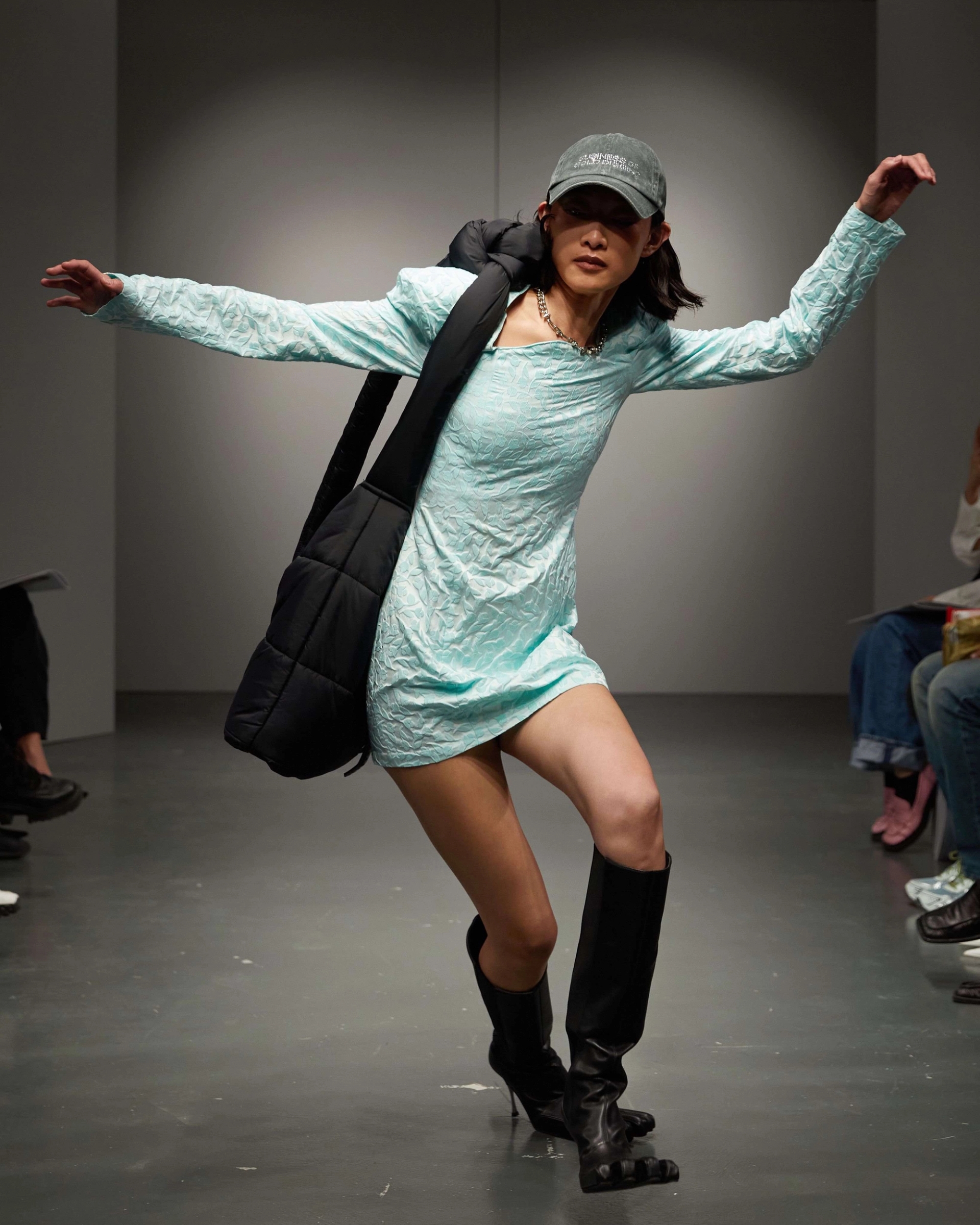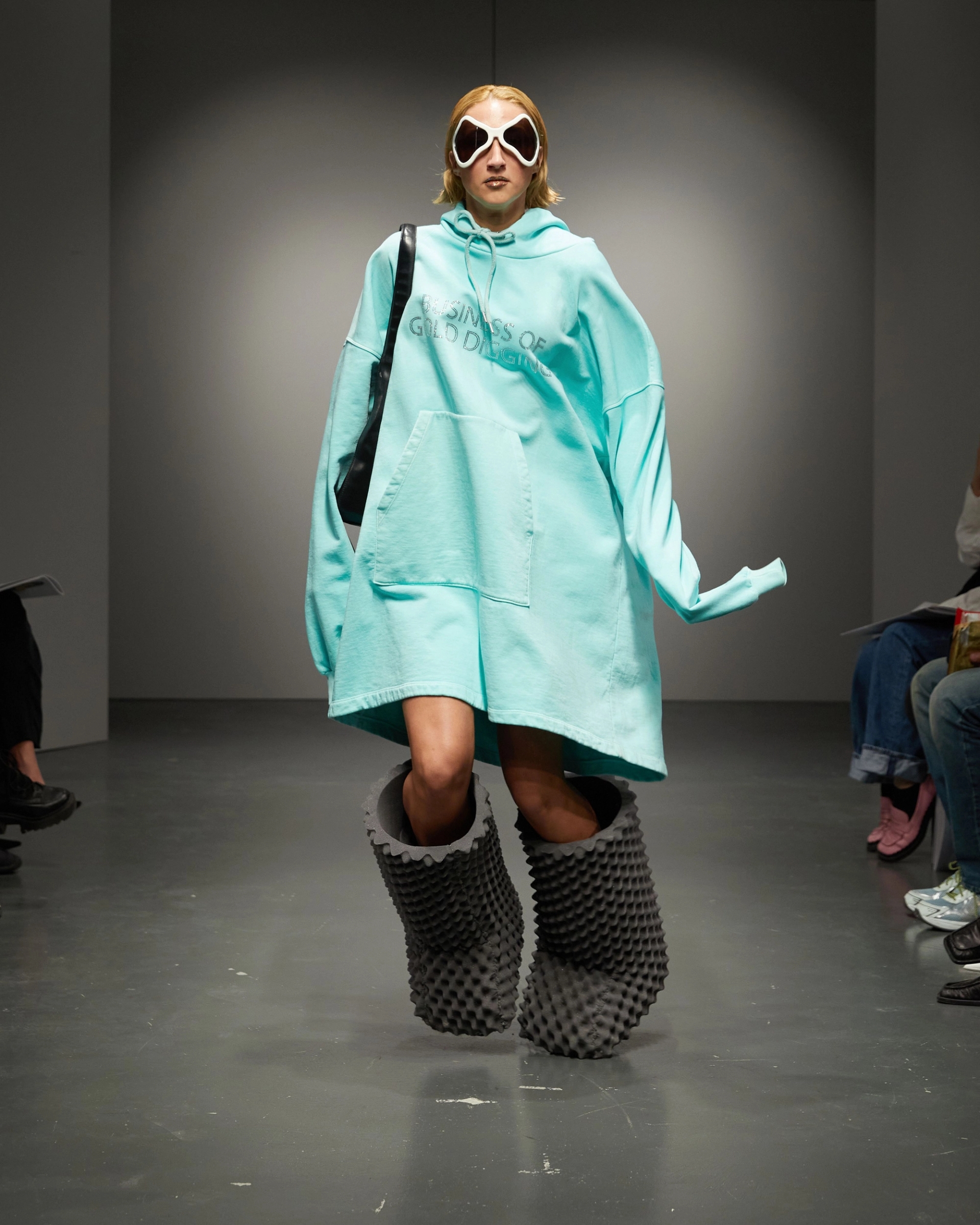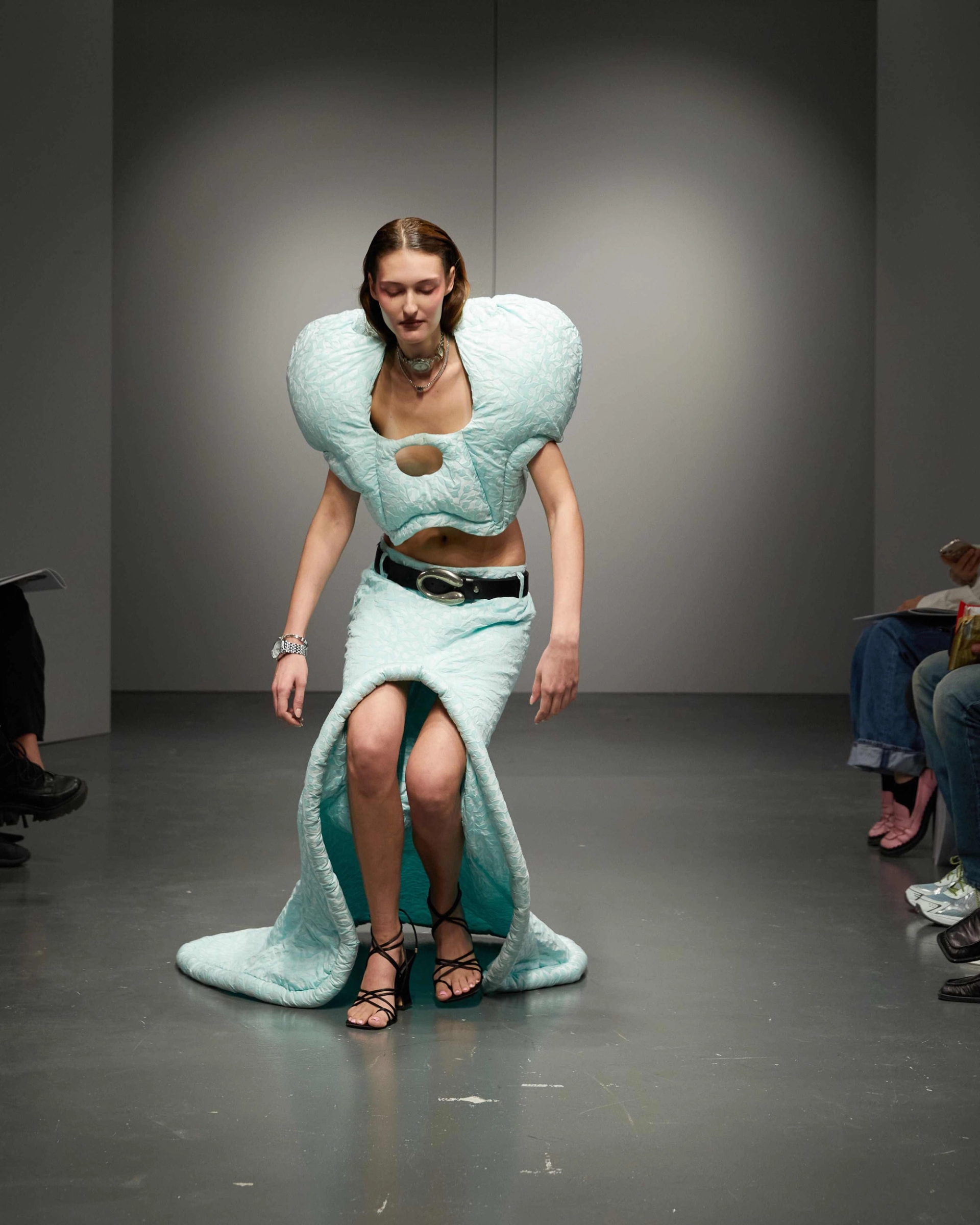Head Over Heels: AVAVAV
BEATE KARLSSON, creative director of AVAVAV, has devoted herself to escapism. She embraces a vulgar style that materializes in gargantuan fur boots and shoes sprouting freaky fingers and claws, which act as a formal exaggeration of Margiela’s iconic Tabis. During Milan Fashion Week, Karlsson presented her SS-23 collection, exploring notions of success and failure as well as the fashion industry’s fixation on status. Drawing on historic runway faux pas where models accidentally fall, Karlsson staged an artistic performance wherein she celebrated rather than cringed at the ultimate awkward fashion moment.
032c’s VICTORIA CAMBLIN exchanged Instagram DMs with the designer, chatting about brands who clickbait, the mainstreaming of phalanges footwear, and the runway as a form of theater.
Designer Beate Karlssson falling on stage herself as part of her SS-23 show at Milan Fashion week.
Victoria Camblin: Beate, how was your PFW? Any special or memorable moments that stand out — at your presentation or somewhere else😊?
Beate Karlsson: It’s been fun and busy, and it actually was the first time I really participated. I’ve been showcasing my collection for the whole week at the Swedish Fashion Council showroom in partnership with Fashion East at 3537's space. It’s been great to finally meet the people who support us IRL. This has been the most redeeming part.
Receiving love and positive responses on my debut show has given me so much energy. I feel very encouraged to further pursue a more performative approach when presenting new collections.
VC: You had a couple big moments right before PFW — AVAVAV went viral. I can imagine that you went into the presentation with amazing energy because of that. Was it an intense experience?
BK: Yes. I did my debut runway show at MFW. It was a performative show where every model entered the runway and then fell. I casted actors and dancers. It was important to me that it looks authentic. I believed in the idea, but definitely didn’t expect it to explode like this.
It has been intense for sure, but it has also been fun. We’re an extremely small team and aren’t used to getting so many requests and endorsement. It’s great. However, I’m expecting some kind of big post-project-depression coming soon haha.
VC: What gave you the idea for the falling? My first response was “I don't think I've ever seen this on the runway before.” So many reprisals exist in fashion. New combos like this rarely happen.
And omg, the come-down, I get it.
I'm also curious how much you were considering Instagram and TikTok when you thought of the falling element. There seems to be such a big divide right now: brands who are creating work and shows that are specifically meant to provoke and translate to Instagram, and those who aren’t.
BK: Obviously, my footwear is a bit clumsy, so I had this “nightmarish” idea that if I ever do a runway show, some models might fall. Then I expanded on that idea, thinking that it’d be funny if it became a domino effect of falls.
When I worked on the concept of the collection, I merged the falling element into a runway performance. I wanted the show to feel like a parody of an early 2000s show with serious models and cool beats.
VC: It’s funny you say that. I did a lot of research on model’s purposefully falling in shows and couldn’t find anything similar, which is odd because it’s such a simple idea.
BK: Social media was definitely a part of the vision from the beginning, mainly because we’re not a big fish. We didn’t know how many ppl we’d be able to pull for a show. Especially, since my friends and network aren’t primarily in Milan, it was important that the show would also be exposed digitally.
I’m definitely gonna embrace the internet. I think it’s a great tool, especially for smaller brands. It has the potential to democratize the landscape for creatives. With this being said, there are definitely annoying parts of algorithms, too. It can be painful to look at brands who chase virality just for the sake of it. I hope ppl are able to distinguish between good ideas and clickbaits.
VC: Did your viral moment change the way you think about your product, and how it functions? Did it additionally change the way you think about the runway? The way you described the choreography in your messages made me think of the runway as a stage in a theater — and, of course, your shows are pretty theatrical. I feel like we've been physically limiting what "the runway" can be.
With the exception of Balenciaga (not to bring the b-word into this...😛).
BK: A part of the emotional grandness in the physical show was slightly lost in the viral version. I wanted to do a slower documentation, showcasing the whole show from beginning to end. The shorter and faster format was better for some, which is a bit sad. I want to show the whole performance at some point, cause the music and reactions were also a big part of it. I worked with my sister, who is a musician, on composing the music for the show, and we combined organ sounds with techno beats.
I think what’s interesting about fashion is that there are so many rules and constrictions. It’s quite fun to break them. For this concept, I wanted the runway to be a little cliché with a classic runway setup. This made the falls more realistic and relatable.
VC: And now it’s circulating with all the different trending soundtracks of TikTok memes. You can also look at it as a metaphor for how work circulates in general. As a designer, you can be as precise and controlling as you want, as soon as it’s in the world, it’s out of your hands.
Do you sometimes think about control or losing control? It would play into the idea of falling.
BK: Haha exactly. A few years ago, I would have probably been more controlling about where my work ends up, and how it circulates in different ways. Today I’m more open. I think it’s interesting to see how different people perceive what I create. I often learn something from that.
The falling symbolized how reality hits you, and how you can’t control it. If you’re engaging in escapism, pretending you’re something you’re not, there will most likely be moments when you lose face.
VC: Picking up on the theme of control, I’ve talked about this with designers of clothes and products as well as with visual artists (not that I am hugely convinced of the distinction anymore, but maybe that's a later question!). To generalize, visual artists seem to tend to admire control in other artists' work and strive to maintain it at all costs, for example, as they often don’t compromise on a single detail — from how the work gets installed in a museum to how it is written about.
Designers who make, let's say, expensive lamps have to design something that feels bespoke, special, and site-specific. But it’s also a product that’s maybe going to be mass-produced and distributed globally. Where do you see your work in terms of scale of production? Do you have set goals, for example, keeping it small, expanding it, or working at both ends of the spectrum?
BK: To me, scaling is very exciting for the products that seem to have no market. Take my finger shoes, for example, I think there’s a potential to scale them, because we’ve noticed a big demand for them. It would warm my heart to see more ppl wearing such products, because it’s not expected.
To me it’s important that the products we potentially scale carry a strong DNA. It wouldn’t feel right to push something out that already exists on the market.
I think now is the first time that we start entering the chapter of scaling. We’re not there yet, but I can see it happening soon. It’s important that we base scaling on demand. Only then we can do it in a way that makes sense in terms of sustainability and brand image. When you get bigger orders and can scale, it’s easier to push the production to be even more green. For the past couple of years, I’ve been navigating how we can use my artistic background to create commercial products that are still meaningful.
VC: Is it logistically easy to produce on demand?
BK: It depends on the product, but in general it’s not easier, which mainly has to do with how quick we expect delivery to be today.
I think it’s important to have integrity when it comes to setting your own deadlines and not get too rushed by the idea of next day delivery. If you set your own rules, you’re less limited, which has a direct effect on the creative process.
Will this view impact how you approach future fashion seasons and industry expectations?
BK: I want to work on establishing new structures.
I don’t have all the answers, but I’m excited to build a process that makes sense for the time we live in, and hopefully it will be rewarding.
VC: In addition to social media, are you exploring any technologies that inform your design process or products?
BK: Hm, I mean I use illustrator and photoshop a lot in the design process, but other than that I don’t think so.
Maybe I misunderstood the question tho?
VC: I just meant the materials you’re using and different ways of working with them, for example. Is there anything new you’re playing with or are excited about?
Also, is there anything else you’ve got coming up? I assume those boots are in crazy high demand right now for shoots.
BK: Ahh ok gotcha. Honestly, the biggest barrier for me to break is time. I want to give myself and the team more time for ideas and production.
Haha yup! We’ve had some really iconic artists reaching out, which is fun. I’m dealing with the logistics of all of this, and soon I’ll be going into the process of my next collection. Although I’ll probably take a few days off cause I’m still a little fuzzy from the past month.


